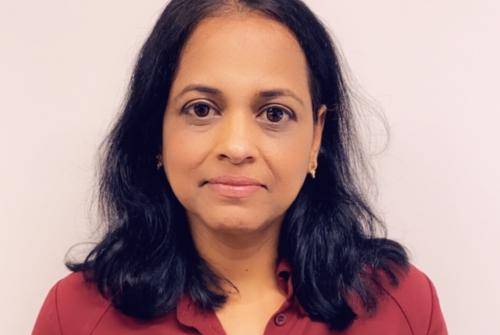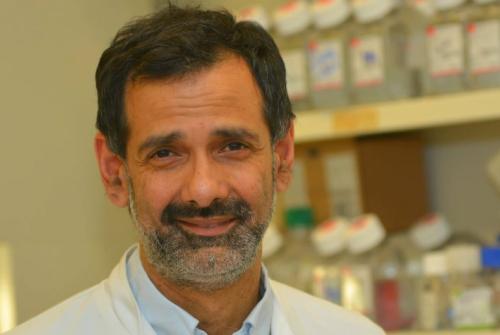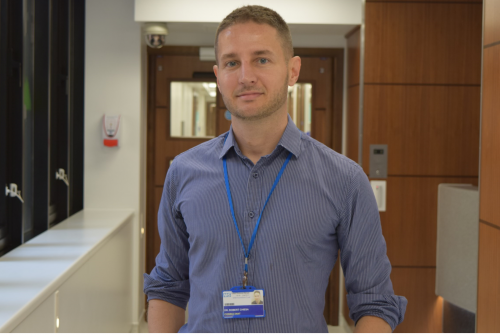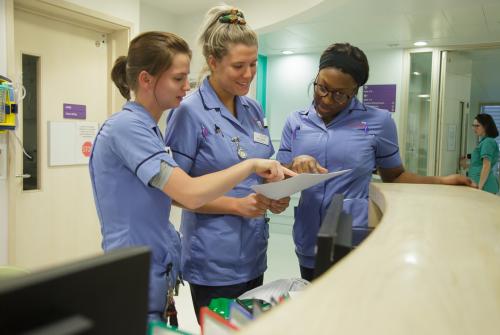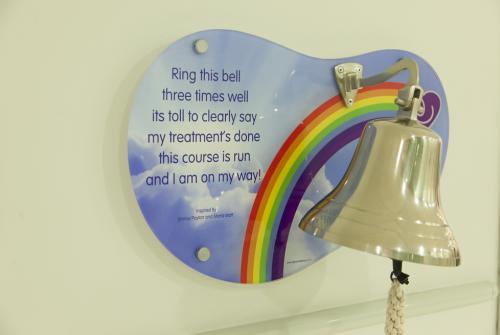Bone Marrow Transplant
Overview
The Bone Marrow Transplant (BMT) Unit is the largest paediatric BMT centre in the UK, performing around 100 stem cell procedures per year. We provide a comprehensive haematopoietic stem cell transplant service for children with life-threatening haematological, immunological, metabolic, rheumatological and gastroenterological conditions.
We offer transplantation from both matched and mismatched donors and have programs encompassing the use of alternative donors from cord blood to haploidentical donors. Only 20% of our patients have suitably matched family donors so many of our transplants are performed from volunteer adult bone marrow, peripheral blood stem cell or cord blood donations. The experience we have in various transplant techniques allows us to offer the most suited transplant option for each patient.
We have significant experience in various types of conditioning regimens from minimal intensity to fully myeloablative and we are able to manage any of those preparatory regimens as best appropriate for the patient/condition.
Great Ormond Street being a third level pediatric hospital, we can access the expertise of many paediatric teams over the hospital in case of complex patients with multiorgan needs. Our journey through a transplant is facilitated by the availability of a number of allied healthcare professionals (physiotherapy, dietician, occupational therapist, play specialists) who are actively involved in the case of the patient to minimize the burden of the transplant-related journey.
GOSH has an onsite paediatric intensive care unit, which our transplanted patients can access in case of life-threatening complications. GOSH hosts a number of innovative treatments as clinical trials, which allow for children beyond the first line of treatment to be referred to GOSH for further consideration of experimental approaches.
Our hospital can accept patients for transplants up to the age of 16 years. The department is JACIE accredited and is able to offer a second opinion service for clinicians from around the world.
The unit specialises in ‘reduced toxicity' conditioning and in cellular therapies for the treatment of viral complications post BMT. We are involved in cutting-edge research with the UCL Institute of Child Health focusing on gene therapy and immunotherapy. Please be aware that private referrals for NHS eligible patients are not possible for this service. This is because children requiring a BMT will need continued and well-coordinated care, and good communication from the outset with their local paediatric services is essential. By entering the private treatment route, we are unable to provide the long-term local support services required.
All patients are transplanted in isolation rooms with positive pressure/HEPA filter and regular airflow change. At GOSH the transplant wards have regular enhanced clinic in common areas to try and reduce environmental contamination. At GOSH we cap the number of carers per patients that can access the isolation cubicles during transplant to 3 people, to limit the possibility of infections being carried to the room of the patient. All personnel is regularly trained is performing care through aseptic techniques. Patients receive regular drugs for antifungal, antiviral and antibacterial prophylaxis throughout transplant.
Clinical outcomes
We measure our transplant outcomes in a range of ways including survival for all conditions treated, survival by groups of similar conditions, and complications of treatment. We audit our activity yearly and we regularly have a 1-year post-transplant overall survival of around 80-85%. This is a result that encompasses all treatment and all conditions.
According to the data in 2020, our overall patient survival for allograft transplants is 83%.
Malignancies have the lowest overall survival rate of all conditions treated by stem cell transplantation because children who have been pre-treated with a lot of chemotherapy, can experience more toxicity during SCT. However, ongoing clinical research at GOSH seeks to learn more about how to treat these conditions to improve survival rates. In 2020, our overall patient survival for allograft transplant – malignancies only - is 85% and disease-free patient survival for allograft transplant – malignancies only – is 78%, achieving a 5-year improvement in a row.
For more information about our clinical outcomes please click here.
Conditions we treat
- Leukaemia
- Solid tumours
- Bone marrow failure
- Immunodeficiency diseases
- Inherited metabolic disorders
- Autoimmune or immune dysregulatory diseases
Refer your child for treatment
Use the form below to refer your child for treatment. A member of our team will be in touch within 2 working days.
Mandatory fields
FAQs
Different types of BMT are named according to the relationship between the patient (recipient) and the person from whom the stem cells are obtained (donor).
STEM CELL TRANSPLANT - Autologous BMT – using the patient’s own stem cells Autologous BMT involve the collection of the patient's own stem cells, either by harvesting bone marrow or peripheral blood stem cells (PBSC's). These cells are then frozen and stored. When required, the cells are reinfused (given back) to the patient after high doses of chemotherapy. When the frozen cells are given back to the patient they will rapidly regrow and replace those cells destroyed by the high dose chemotherapy. Because the marrow is that of the patient, there are fewer complications than after a transplant using bone marrow from another individual. An Autologous BMT is most commonly used to allow bigger doses of chemotherapy or radiotherapy to be given to treat oncology tumours such as neuroblastoma and medulloblastoma.
CAR T cell therapy - same theory as stem cell transplant but the patient's cells are sent away for 'manufacturing' before being reimplanted in the patient GOSH was the first hospital in the UK to offer a new pioneering cancer therapy to patients with leukaemia. Patients with B-cell acute lymphoblastic leukaemia (ALL) can now receive the new personalised treatment, known as CAR-T therapy. This is the first treatment of its kind to become available to UK and international patients in the UK CAR-T therapies are specifically tailored for individual patients and work by harnessing the patient’s own immune system to fight cancer. In a complex manufacturing process, immune cells are taken from a patient’s blood and reprogrammed to specifically to target and kill cancer cells. ALL is a severe form of leukaemia that affects around 600 people per year, most of whom are children between the age of 2 and 5. Although the outlook for children with ALL has dramatically improved over the last decade, 10-15% of patients still do not respond to standard treatments. This therapy has been shown to be effective in treating patients with particularly aggressive or relapsed cancers where other treatments have failed.
Allogeneic BMT - using donor cells for the patient Allogeneic BMT are transplants from a donor. The most common and most suitable donor used is a brother or sister of the patient. HLA antigens, the tissue typing groups important in establishing compatibility between donor and recipient, are inherited half from each parent. This means any brother / sister pair have a 1:4 chance of being HLA identical and therefore suitable as a donor / recipient pair for a BMT. Unless parents are related ie. cousins, they are rarely suitable as donors for their children. Sometimes however, a search in the extended family may identify a suitable relative (parent, grandparent, aunt or uncle ) who is fully matched or only mismatched at one of the 6 major HLA antigens. A relative who matches at 5:6 of the HLA antigens is a suitable donor for a transplant but more complications are expected than if a fully matched brother or sister is the donor.
MUD - Matched unrelated donor Patients who do not have a suitable donor in the family, may find an unrelated donor on one of the world wide Volunteer Bone Marrow Donor registries. Searching these registries and identifying a suitable donor is a time consuming and expensive exercise. Although a donor will not be identified for all patients, many who otherwise could not have a BMT are now able to benefit from the good will of these volunteers. As with a family mismatched donor, the risks associated with a matched unrelated donor BMT (MUD) are greater than with a sibling transplant. Should your child require a MUD BMT the consultant will provide you with more detailed information.
CORD Cell Transplant Cord blood is the blood that remains in the placenta and umbilical cord following the birth of a baby. It is rich in blood stem cells (similar to those found in bone marrow) and these can be used to treat many different cancers, immune deficiencies and genetic disorders. Large banks of stored, donated cord bloods are now available for searching around the world and may provide suitable stem cells even when no bone marrow donor is available. Cord blood is being used increasingly as a source of stem cells for transplantation instead of bone marrow.
All patients are transplanted in isolation rooms with positive pressure/HEPA filters and regular airflow changes. At GOSH the transplant wards have regular enhanced clinics in common areas to try and reduce environmental contamination. At GOSH we cap the number of carers per patient that can access the isolation cubicles during transplant to 3 people, to limit the possibility of infections being carried to the room of the patient. All personnel is regularly trained is performing care through aseptic techniques. Patients receive regular drugs for antifungal, antiviral, and antibacterial prophylaxis throughout the transplant.
Donor search at GOSH is conducted through Antony Nolan which is the accredited UK agency for worldwide donor search. A preliminary idea of how successful a donor search is can be conducted within 2 weeks from receiving the patient blood sample. Once this preliminary search is finalised, we will be in the position of understanding if the patient has a likelihood of having a full-matched donor or not. This is relevant information as if there are reduced chances of a matched donor the decision could be made (depending on patients' need and disease characteristics) to switch to a haploidentical donor to avoid delays in transplant.
In some other circumstances, where transplant might not be urgent, we would continue searching the registry to identify the best donor among the potentially available. In the best-case scenario, a cord blood unit can be available for transplant within 4 weeks from starting the search and an unrelated adult donor within 6 weeks. Obviously, when the donor is an unrelated adult donor, some constraints are related to the schedule of the donor. In this setting, it is very convenient to be in a centre (like GOSH) , which offers transplants from various sources/donors as that gives the patient the best choice of receiving the most appropriate transplantation in the most appropriate time frame from the best available donor.
Indications for autologous and allogeneic stem cell transplant are standardized at national levels, and GOSH complies with national guidelines to this regard. A very broad explanation could be that children with leukemia/lymphoma who fail conventional chemotherapy are candidate for allogeneic stem cell transplant whereas autologous transplant is used for solid tumor treatment. Congenital immunological or metabolic disorders are amenable to allogeneic stem cell transplant
This will depend on the trial, on the ability of the referring country to comply with long-term follow-up, and on the trial specifications. There have been private patients enrolled on some of these trials before, but the problematic point had previously been guaranteeing compliance to the long-term follow up which requires the patient to travel to London on a yearly basis for up to 10 years post-treatment for trial-related follow-ups.
